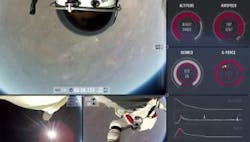We’ve covered a fair amount of instances of vision systems operating in space (Here, here, and here, for example), but in this particular example, I’m not sure anyone has ever seen anything remotely similar.
You’ll likely recall that a little more than one year ago, the Red Bull Stratos skydive saw Austrian daredevil / crazy person Felix Baumgartner jump from the edge of space. On live television, he fell from the edge of space at a speed of about 833.9 mph, breaking the sound barrier. He fell for a total of four minute and twenty-two seconds!
In honor of the anniversary of the death-defying stunt, Red Bull has uploaded video footage from the three action cameras strapped to Baumgartner during the dive. Two small HD video cameras were strapped to his thighs, and one on his chest pack. Prior to the jump, the anticipation of the jump was captured with nine HD cameras, three 4K digital cinematography cameras, and three digital still cameras. All cameras for the jump were designed and developed by Flightline Films.
In order for these cameras to work properly, all of them had to be tested in a special chamber that simulates the conditions of high altitude and space. The suit cameras needed to be tested in order to function in near-space conditions for up to 20 minutes. This includes being able to work at supersonic speed and filming in any direction. In other words, not just any camera system would do.
So how well did they work? You tell me:
While this isn’t the first time that cameras were used in space, the conditions in which they were prepared for, and deployed in, are groundbreaking. What kind of other application do you think cameras that are able to operate in such conditions be used for?
About the Author

James Carroll
Former VSD Editor James Carroll joined the team 2013. Carroll covered machine vision and imaging from numerous angles, including application stories, industry news, market updates, and new products. In addition to writing and editing articles, Carroll managed the Innovators Awards program and webcasts.
